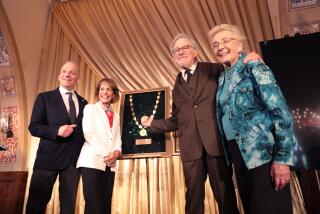To remember and learn
- Share via
AUGUSTA, MAINE — With a succession of four curved rooflines arching toward the southern sky before ending abruptly with walls of glass, the architecture is striking. But inside the new home of Maine’s Holocaust and Human Rights Center, visitors may find what they see and hear even more moving.
Survivors of the Nazi horrors and their liberators will appear on four screens to tell stories of what they experienced during those dark days. As a backdrop to their words, ambient sounds from the death camps will fill the air.
For the record:
12:00 a.m. April 18, 2007 For The Record
Los Angeles Times Wednesday April 18, 2007 Home Edition Main News Part A Page 2 National Desk 1 inches; 67 words Type of Material: Correction
Holocaust center: An article in the April 2 Calendar section about the Holocaust and Human Rights Center of Maine’s new Michael Klahr Center said that Klahr, a Holocaust survivor, had become wealthy in New York, then moved to Maine and married Phyllis Jalbert. Klahr married Jalbert, a former Maine resident, in New York, where the couple lived. She donated funds for the Maine project in his memory.
Visitors will see a letter from a GI to his sweetheart describing what he saw as he became one of the first Americans to liberate the death camps. Outside, a small plot of ground will hold earth from Auschwitz-Birkenau, following a ceremony on April 15, Holocaust Remembrance Day.
For years, mementos, tapes and other material pertaining to Mainers who survived or helped to liberate the concentration camps of the World War II era were scattered in different locations. Tapes were housed in the state library.
Other items wound up in Sharon Nichols’ home.
A Catholic who developed a deep interest in the Holocaust during a visit to Germany in the 1960s, Nichols found herself consumed by questions about how people could inflict such cruelty on fellow humans and how anything like it can be prevented in the future.
Last year -- 21 years after the Holocaust and Human Rights Center was founded -- ground was broken for its permanent home.
The Michael Klahr Center is named in honor of a child Holocaust survivor who eventually settled in Maine. Klahr was born in Paris in 1937. His mother was deported and probably killed, and his father was shot by the Nazis. In 1946, Klahr arrived on an orphan ship in the United States. He became wealthy in New York after investing in real estate. He later moved to Maine, where he married Phyllis Jalbert. The two ran sporting camps until Klahr died in 1998.
Nichols said the timing is right for the $2.8-million, 6,000-square-foot Klahr Center to open because survivors and liberators who serve as the backbone of public outreach efforts are now old and dying.
And having it on the University of Maine at Augusta campus solidifies an educational link between the UM system and the human-rights mission of the Holocaust center, said Sheri Stevens, the university’s vice president for administration.
“It makes us feel pretty special,” she said. “We’re really honored it’s on our campus.”
Researchers will find a rich archive of reference material at the site, which is attached to the school’s library.
In the Klahr Center, teachers will attend seminars focusing on issues such as diversity. A symposium planned for October will cover the topic of the Holocaust and medical ethics, said Bob Katz, an art professor and member of the center’s board.
Katz emphasized that the center, which is scheduled to open formally on Sept. 19, is not a museum, which, he said, suggests a lifeless collection of objects from the past. He sees the center as an active, living resource for learning lessons of the past and applying them to today’s world.
The positive message carries over into the very design of the structure, which avoids death camp imagery.
Harold Hon of the Boston-based firm Shepley Bulfinch Richardson and Abbott said he and fellow architect Son Wooten visited other Holocaust centers and museums and read up on the Maine group’s mission as they formulated a design.
“We came up with the idea of a flower,” Hon said. “The lightbulb went on, and so we tried to have fun.”
They ended up with a design that resembles petals of a flower, a symbol of life and renewal.
The Augusta university provided a long-term lease for the land and will own and maintain the Klahr Center. Its benefactors include author Stephen King and Klahr’s widow, Jalbert. The Klahr Center still must raise $1 million.
More to Read
Sign up for The Wild
We’ll help you find the best places to hike, bike and run, as well as the perfect silent spots for meditation and yoga.
You may occasionally receive promotional content from the Los Angeles Times.






